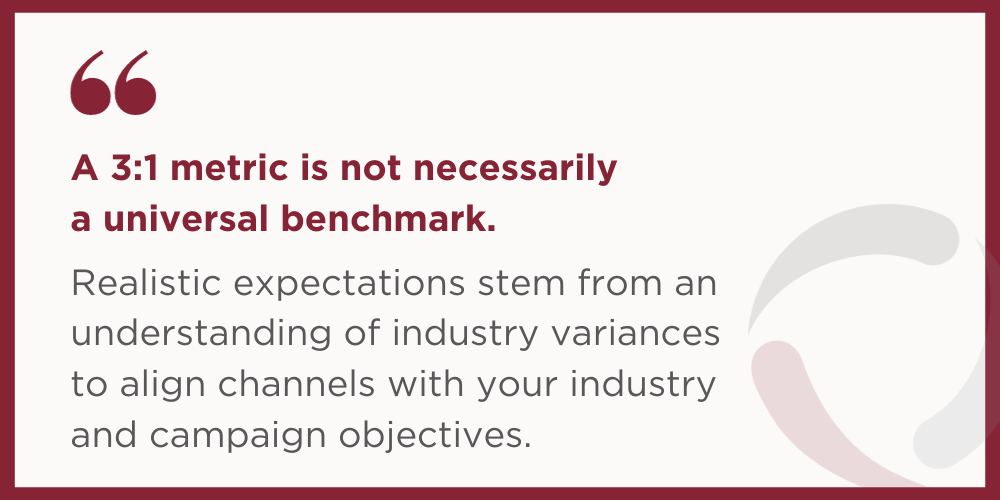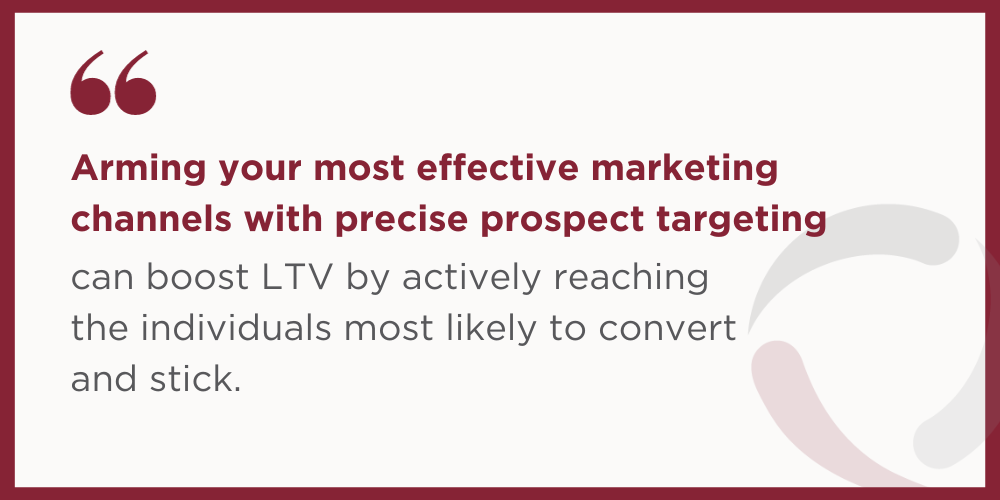Optimizing Your Direct Response LTV:CAC Ratio

One of the key metrics used to measure marketing efficiency in direct response marketing campaigns is the LTV:CAC ratio.
Many marketers agree that the ideal ratio between Customer Lifetime Value (LTV) and Customer Acquisition Cost (CAC) is 3:1. This means that for every dollar you invest in acquiring customers, you can expect to receive three dollars in return. Yet, achieving the golden 3:1 ratio remains a challenge for brands looking for profitable growth, especially when testing new direct marketing channels or campaign elements. Since campaign success is measured by its ability to generate revenue and foster long-term customer relationships, identifying the most effective marketing channels is crucial to protecting your marketing dollar investments, gaining a competitive advantage beyond cost efficiency, and improving business performance.
In this post, we’ll explore what the direct response LTV:CAC ratio means, how it can be optimized, and review case studies from DTC brands that have successfully increased customer lifetime value with direct mail.
|
Prefer to listen? Check out our podcast The Direct Effect: Optimizing Your Direct Response LTV:CAC Ratio |
Why is the LTV:CAC Ratio Important?
The LTV:CAC ratio essentially measures the efficiency of your marketing and sales efforts.
At the core of direct marketing performance lies LTV, which represents the total revenue a business expects to earn from a customer throughout their relationship. CAC is the financial investment required to acquire a new customer through a specific marketing channel. Balancing LTV and CAC is critical, as a higher CAC can be justified if it produces customers with a high LTV – this is where brands begin to unlock the rate of affordable customer acquisition while maximizing long-term value.
Industry Variances and Impact on LTV and CAC Expectations
Industry and individual channel benchmarks serve as a compass to shape realistic campaign expectations and effectively allocate resources. Each industry exhibits distinct customer behaviors, sales cycles, and competitive landscapes. And each marketing channel has its own unique metrics, costs, and conversion rates. Consumer behavior is deeply influenced by market trends, economic conditions, and technological advancements. Therefore, a 3:1 metric is not necessarily a universal benchmark. Realistic expectations stem from an understanding of these variances to align channels with your industry and campaign objectives.

How to Align Short-Term Goals with Long-Term Success
Some businesses mistakenly prioritize short-term sales gains over long-term customer value. This approach to measuring channel performance can result in aggressive customer acquisition strategies that drive up CAC without considering the long-term potential of cultivating customer loyalty. Allocating resources to ineffective marketing channels can lead to a higher CAC without a proportional increase in LTV. One example of this could be investing in digital marketing channels known for high impressions and clicks, yet the downside of unreliable audience data is the impact to conversion quality and customer retention.
Arming your most effective marketing channels with precise prospect targeting can boost LTV by actively reaching the individuals most likely to convert (and stick), rather than wasting impressions on an audience of “one and done” buyers. One example of a high-performance channel is direct mail. Marketers using this channel have found success in leveraging offline data sources to analyze past spending behaviors and accurately predict future purchases and high value customers.
How to Improve Your Direct Response LTV:CAC Ratio
Test.
To identify the most cost-effective marketing channels, a sustainable approach to direct marketing campaign testing will provide quick learnings, focus resources on impactful variables, and can be replicated for larger marketing spend. This will allow you to test audiences, channels, offers, and creative strategies to quickly identify which combinations will provide the best performance and long-term success. Consider testing strategies based on fractional factorial design and leverage test matrices that accurately predict performance, while minimizing risk and maximizing learning.
Always track and analyze your results to make data-driven decisions that will improve your future campaigns and increase your direct response LTV:CAC ratio.

Case Study: Cracking the LTV:CAC Code with Direct Mail
In the competitive realm of identity theft protection, a forward-thinking brand was eager to optimize its LTV to CAC ratio for improved cost efficiency, customer loyalty, and brand recognition.
The Test: Direct Mail Concept vs. Control Package
The identity theft protection company focused on enhancing their direct mail program, pitting a new test package against the established control package. Sales rate results showed the test package trailing behind the control by 15% overall. This outcome was initially viewed as a setback, yet a closer look at the performance data revealed a silver lining that would prove pivotal as the brand worked towards an improved direct mail LTV:CAC ratio.
A Deeper Dive: Unveiling the Insights
Despite the lower overall sales rate, customers who converted via the test package exhibited a 50% higher propensity to purchase the premium version of the identity theft protection product. This revelation was a game-changer. It suggested that while the test package might have struggled in immediate conversions, it had successfully captured a segment of customers with a significantly higher long-term value.
The Turning Point: Revenue Per Piece Triumphs
In the end, the test package managed to beat the control by 6.25% in revenue per piece. This success was not merely a win in immediate sales but a strategic win in enhancing the LTV. By recognizing the nuanced customer behaviors and preferences captured by the test package, the identity theft protection company turned a seemingly unsuccessful campaign into a powerful tool for LTV:CAC improvement. Ultimately, the test package’s success in generating higher revenue per piece underscored the importance of prioritizing customer value over short-term gains.
Key Takeaways
Direct mail is a direct response channel known for its strong customer acquisition and lifetime value performance, and an optimized direct mail plan allows marketers to reach their LTV:CAC goals. To wrap up this article, we’ll leave you with one more example of how a produce subscription brand used mail to provide scale and generate high LTV customers.
A digital-heavy marketing strategy propelled this growing brand into the market, but it was time to diversify with offline channels. Within a month of deploying the inaugural direct mail campaign, the data-driven strategy had a positive impact on the brand’s overall customer value and acquisition efforts. The campaign generated more than 750 new sales and achieved an overall CPA of only $76. The brand’s Chief Operating Officer agreed SeQuel’s approach to direct mail produced “a solid audience strategy that delivers higher LTV customers.”
By targeting the right audience on the right channel, you too can improve your LTV:CAC ratio. Contact us to learn more about the tips and examples shared in this article, or check out this blog post on understanding LTV’s role in setting direct mail CPA targets. This infographic also shares 6 Common Direct Mail KPIs and how to calculate them.

